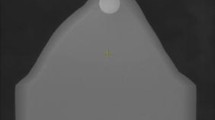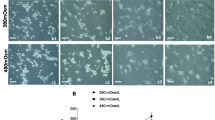Abstract
The objective of this study was to evaluate the effect of sample preparation on the biomechanical behaviour of chondrocytes. We compared the volumetric and dimensional changes of chondrocytes in the superficial zone (SZ) of intact articular cartilage and cartilage explant before and after a hypotonic challenge. Calcein-AM labelled SZ chondrocytes were imaged with confocal laser scanning microscopy through intact cartilage surfaces and through cut surfaces of cartilage explants. In order to clarify the effect of tissue composition on cell volume changes, Fourier Transform Infrared microspectroscopy was used for estimating the proteoglycan and collagen contents of the samples. In the isotonic medium (300 mOsm), there was a significant difference (p < 0.05) in the SZ cell volumes and aspect ratios between intact cartilage samples and cartilage explants. Changes in cell volumes at both short-term (2 min) and long-term (2 h) time points after the hypotonic challenge (180 mOsm) were significantly different (p < 0.05) between the groups. Further, proteoglycan content was found to correlate significantly (r 2 = 0.63, p < 0.05) with the cell volume changes in cartilage samples with intact surfaces. Collagen content did not correlate with cell volume changes. The results suggest that the biomechanical behaviour of chondrocytes following osmotic challenge is different in intact cartilage and in cartilage explant. This indicates that the mechanobiological responses of cartilage and cell signalling may be significantly dependent on the integrity of the mechanical environment of chondrocytes.
Similar content being viewed by others
References
Albro MB, Petersen LE, Li R, Hung CT, Ateshian GA (2009) Influence of the partitioning of osmolytes by the cytoplasm on the passive response of cells to osmotic loading. Biophys J 97(11): 2886–2893
Alyassin AM, Lancaster JL, Downs JH 3rd, Fox PT (1994) Evaluation of new algorithms for the interactive measurement of surface area and volume. Med Phys 21(6): 741–752
Arokoski JP, Jurvelin JS, Väätäinen U, Helminen HJ (2000) Normal and pathological adaptations of articular cartilage to joint loading. Scand J Med Sci Sports 10(4): 186–198
Ateshian GA, Likhitpanichkul M, Hung CT (2006) A mixture theory analysis for passive transport in osmotic loading of cells. J Biomech 39(3): 464–475
Bader DL, Kempson GE, Barrett AJ, Webb W (1981) The effects of leucocyte elastase on the mechanical properties of adult human articular cartilage in tension. Biochim Biophys Acta 677(1): 103–108
Bi X, Yang X, Bostrom MP, Camacho NP (2006) Fourier transform infrared imaging spectroscopy investigations in the pathogenesis and repair of cartilage. Biochim Biophys Acta 1758(7): 934–941
Boskey A, Pleshko Camacho N (2007) FT-IR imaging of native and tissue-engineered bone and cartilage. Biomaterials 28(15): 2465–2478
Brown H, Prescott R (2006) Applied mixed models in medicine. Wiley, New York
Bush PG, Hall AC (2001a) Regulatory volume decrease (RVD) by isolated and in situ bovine articular chondrocytes. J Cell Physiol 187(3): 304–314
Bush PG, Hall AC (2001b) The osmotic sensitivity of isolated and in situ bovine articular chondrocytes. J Orthop Res 19(5): 768–778
Bush PG, Hall AC (2003) The volume and morphology of chondrocytes within non-degenerate and degenerate human articular cartilage. Osteoarthr Cartil 11(4): 242–251
Bush PG, Hall AC (2005) Passive osmotic properties of in situ human articular chondrocytes within non-degenerate and degenerate cartilage. J Cell Physiol 204(1): 309–319
Bush PG, Wokosin DL, Hall AC (2007) Two-versus one photon excitation laser scanning microscopy: critical importance of excitation wavelength. Front Biosci 12: 2646–2657
Camacho NP, West P, Torzilli PA, Mendelsohn R (2001) FTIR microscopic imaging of collagen and proteoglycan in bovine cartilage. Biopolymers 62(1): 1–8
Chao PG, West AC, Hung CT (2006) Chondrocyte intracellular calcium, cytoskeletal organization, and gene expression responses to dynamic osmotic loading. Am J Physiol Cell Physiol 291(4): C718–C725
Clark AL, Votta BJ, Kumar S, Liedtke W, Guilak F (2010) Chondroprotective role of the osmotically sensitive ion channel transient receptor potential vanilloid 4. Arthritis Rheum 62(10): 2973–2983
Dumont J, Ionescu M, Reiner A, Poole AR, Tran-Khanh N, Hoemann CD, McKee MD, Buschmann MD (1999) Mature full-thickness articular cartilage explants attached to bone are physiologically stable over long-term culture in serum-free media. Connect Tissue Res 40(4): 259–272
Eisenberg SR, Grodzinsky AJ (1985) Swelling of articular cartilage and other connective tissues: electromechanochemical forces. J Orthop Res 3(2): 148–159
Errington RJ, Fricker MD, Wood JL, Hall AC, White NS (1997) Four-dimensional imaging of living chondrocytes in cartilage using confocal microscopy: a pragmatic approach. Am J Physiol 272(3 Pt 1): C1040–1051
Federico S, Herzog W (2008) On the anisotropy and inhomogeneity of permeability in articular cartilage. Biomech Model Mechanobiol 7(5): 367–378
Flahiff C, Narmoneva D, Huebner J, Kraus V, Guilak F, Setton L (2002) Osmotic loading to determine the intrinsic material properties of guinea pig knee cartilage. J Biomech 35(9): 1285–1290
Gardner DL (1965) Pathology of the connective tissue diseases. Edvard Arnold, London
Guilak F, Ratcliffe A, Mow VC (1995) Chondrocyte deformation and local tissue strain in articular cartilage: a confocal microscopy study. J Orthop Res 13(3): 410–421
Grushko G, Schneiderman R, Maroudas A (1989) Some biochemical and biophysical parameters for the study of the pathogenesis of osteoarthritis: a comparison between the processes of ageing and degeneration in human hip cartilage. Connect Tissue Res 19(2–4): 149–176
Han SK, Colarusso P, Herzog W (2009) Confocal microscopy indentation system for studying in situ chondrocyte mechanics. Med Eng Phys 31(8): 1038–1042
Han SK, Seerattan R, Herzog W (2010) Mechanical loading of in situ chondrocytes in lapine retropatellar cartilage after anterior cruciate ligament transection. J R Soc Interface 7(47): 895–903
Hoffmann EK, Dunham PB (1995) Membrane mechanisms and intracellular signalling in cell volume regulation. Int Rev Cytol 161: 173–262
Hopewell B, Urban JP (2003) Adaptation of articular chondrocytes to changes in osmolality. Biorheology 40(1–3): 73–77
Jurvelin JS, Buschmann MD, Hunziker EB (1997) Optical and mechanical determination of Poisson’s ratio of adult bovine humeral articular cartilage. J Biomech 30(3): 235–241
Kedem O, Katchalsky A (1958) Thermodynamic analysis of the permeability of biological membranes to non-electrolytes. Biochim Biophys Acta 27(2): 229–246
Kiviranta I, Jurvelin J, Tammi M, Säämänen AM, Helminen HJ (1985) Microspectrophotometric quantitation of glycosaminoglycans in articular cartilage sections stained with Safranin O. Histochemistry 82(3): 249–255
Kleinhans FW (1998) Membrane permeability modeling: Kedem-Katchalsky vs a two-parameter formalism. Cryobiology 37(4): 271–289
Korhonen RK, Han SK, Herzog W (2010a) Osmotic loading of articular cartilage modulates cell deformations along primary collagen fibril directions. J Biomech 43(4): 783–787
Korhonen RK, Han SK, Herzog W (2010b) Osmotic loading of in situ chondrocytes in their native environment. Mol Cell Biomech 7(3): 125–134
Korhonen RK, Herzog W (2008) Depth-dependent analysis of the role of collagen fibrils, fixed charges and fluid in the pericellular matrix of articular cartilage on chondrocyte mechanics. J Biomech 41(2): 480–485
Korhonen RK, Julkunen P, Wilson W, Herzog W (2008) Importance of collagen orientation and depth-dependent fixed charge densities of cartilage on mechanical behavior of chondrocytes. J Biomech Eng 130(2): 021003
Kouri JB, Arguello C, Luna J, Mena R (1998) Use of microscopical techniques in the study of human chondrocytes from osteoarthritic cartilage: an overview. Microsc Res Tech 40(1): 22–36
Likhitpanichkul M, Guo XE, Mow VC (2005) The effect of matrix tension-compression nonlinearity and fixed charges on chondrocyte responses in cartilage. Mol Cell Biomech 2(4): 191–204
Maroudas A (1979) Physico-chemical properties of articular cartilage. In: Freeman M (eds) Adult articular cartilage. Alden Press, Oxford, pp 131–170
Maroudas A, Bannon C (1981) Measurement of swelling pressure in cartilage and comparison with the osmotic pressure of constituent proteoglycans. Biorheology 18(3–6): 619–632
Maroudas A, Venn M (1977) Chemical composition and swelling of normal and osteoarthrotic femoral head cartilage. II. Swelling. Ann Rheum Dis 36(5): 399–406
McDevitt CA, Muir H (1976) Biochemical changes in the cartilage of the knee in experimental and natural osteoarthritis in the dog. J Bone Joint Surg Br 58(1): 94–101
Mow VC, Ratcliffe A, Poole AR (1992) Cartilage and diarthrodial joints as paradigms for hierarchical materials and structures. Biomaterials 13(2): 67–97
Narmoneva DA, Wang JY, Setton LA (1999) Nonuniform swelling-induced residual strains in articular cartilage. J Biomech 32(4): 401–408
Negoro K, Kobayashi S, Takeno K, Uchida K, Baba H (2008) Effect of osmolarity on glycosaminoglycan production and cell metabolism of articular chondrocyte under three-dimensional culture system. Clin Exp Rheumatol 26(4): 534–541
Poole CA, Ayad S, Gilbert RT (1992) Chondrons from articular cartilage. V. Immunohistochemical evaluation of type VI collagen organisation in isolated chondrons by light, confocal and electron microscopy. J Cell Sci 103(Pt 4): 1101–1110
Saarakkala S, Julkunen P, Kiviranta P, Mäkitalo J, Jurvelin JS, Korhonen RK (2010) Depth-wise progression of osteoarthritis in human articular cartilage: investigation of composition, structure and biomechanics. Osteoarthr Cartil 18: 73–81
Schmidt MB, Mow VC, Chun LE, Eyre DR (1990) Effects of proteoglycan extraction on the tensile behavior of articular cartilage. J Orthop Res 8(3): 353–363
Schneiderman R, Keret D, Maroudas A (1986) Effects of mechanical and osmotic pressure on the rate of glycosaminoglycan synthesis in the human adult femoral head cartilage: an in vitro study. J Orthop Res 4(4): 393–408
Stockwell RA (1991) Cartilage failure in osteoarthritis: Relevance of normal structure and function. A review. Clin Anat 4: 161–191
Turunen SM, Lammi M, Saarakkala S, Han S-K, Herzog W, Tanska P, Korhonen RK (2011) Hypotonic challenge alters cell volumes differently in enzymatically treated and intact articular cartilage. Trans Orthop Res Soc 36: 2171
Urban JP (1994) The chondrocyte: a cell under pressure. Br J Rheumatol 33(10): 901–908
Urban JP, Bayliss MT (1989) Regulation of proteoglycan synthesis rate in cartilage in vitro: influence of extracellular ionic composition. Biochim Biophys Acta 992(1): 59–65
Urban JP, Hall AC, Gehl KA (1993) Regulation of matrix synthesis rates by the ionic and osmotic environment of articular chondrocytes. J Cell Physiol 154(2): 262–270
Watson PJ, Carpenter TA, Hall LD, Tyler JA (1996) Cartilage swelling and loss in a spontaneous model of osteoarthritis visualized by magnetic resonance imaging. Osteoarthr Cartil 4(3): 197–207
Wilson W, van Donkelaar CC, Huyghe JM (2005) A comparison between mechano-electrochemical and biphasic swelling theories for soft hydrated tissues. J Biomech Eng 127(1): 158–165
Author information
Authors and Affiliations
Corresponding author
Rights and permissions
About this article
Cite this article
Turunen, S.M., Lammi, M.J., Saarakkala, S. et al. Hypotonic challenge modulates cell volumes differently in the superficial zone of intact articular cartilage and cartilage explant. Biomech Model Mechanobiol 11, 665–675 (2012). https://doi.org/10.1007/s10237-011-0341-z
Received:
Accepted:
Published:
Issue Date:
DOI: https://doi.org/10.1007/s10237-011-0341-z




